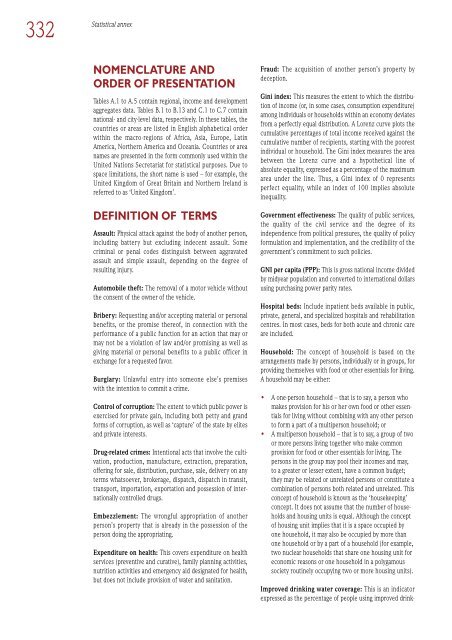Download the file - United Nations Rule of Law
Download the file - United Nations Rule of Law
Download the file - United Nations Rule of Law
- No tags were found...
Create successful ePaper yourself
Turn your PDF publications into a flip-book with our unique Google optimized e-Paper software.
332Statistical annexNOMENCLATURE ANDORDER OF PRESENTATIONTables A.1 to A.5 contain regional, income and developmentaggregates data. Tables B.1 to B.13 and C.1 to C.7 containnational- and city-level data, respectively. In <strong>the</strong>se tables, <strong>the</strong>countries or areas are listed in English alphabetical orderwithin <strong>the</strong> macro-regions <strong>of</strong> Africa, Asia, Europe, LatinAmerica, Nor<strong>the</strong>rn America and Oceania. Countries or areanames are presented in <strong>the</strong> form commonly used within <strong>the</strong><strong>United</strong> <strong>Nations</strong> Secretariat for statistical purposes. Due tospace limitations, <strong>the</strong> short name is used – for example, <strong>the</strong><strong>United</strong> Kingdom <strong>of</strong> Great Britain and Nor<strong>the</strong>rn Ireland isreferred to as ‘<strong>United</strong> Kingdom’.DEFINITION OF TERMSAssault: Physical attack against <strong>the</strong> body <strong>of</strong> ano<strong>the</strong>r person,including battery but excluding indecent assault. Somecriminal or penal codes distinguish between aggravatedassault and simple assault, depending on <strong>the</strong> degree <strong>of</strong>resulting injury.Automobile <strong>the</strong>ft: The removal <strong>of</strong> a motor vehicle without<strong>the</strong> consent <strong>of</strong> <strong>the</strong> owner <strong>of</strong> <strong>the</strong> vehicle.Bribery: Requesting and/or accepting material or personalbenefits, or <strong>the</strong> promise <strong>the</strong>re<strong>of</strong>, in connection with <strong>the</strong>performance <strong>of</strong> a public function for an action that may ormay not be a violation <strong>of</strong> law and/or promising as well asgiving material or personal benefits to a public <strong>of</strong>ficer inexchange for a requested favor.Burglary: Unlawful entry into someone else’s premiseswith <strong>the</strong> intention to commit a crime.Control <strong>of</strong> corruption: The extent to which public power isexercised for private gain, including both petty and grandforms <strong>of</strong> corruption, as well as ‘capture’ <strong>of</strong> <strong>the</strong> state by elitesand private interests.Drug-related crimes: Intentional acts that involve <strong>the</strong> cultivation,production, manufacture, extraction, preparation,<strong>of</strong>fering for sale, distribution, purchase, sale, delivery on anyterms whatsoever, brokerage, dispatch, dispatch in transit,transport, importation, exportation and possession <strong>of</strong> internationallycontrolled drugs.Embezzlement: The wrongful appropriation <strong>of</strong> ano<strong>the</strong>rperson’s property that is already in <strong>the</strong> possession <strong>of</strong> <strong>the</strong>person doing <strong>the</strong> appropriating.Expenditure on health: This covers expenditure on healthservices (preventive and curative), family planning activities,nutrition activities and emergency aid designated for health,but does not include provision <strong>of</strong> water and sanitation.Fraud: The acquisition <strong>of</strong> ano<strong>the</strong>r person’s property bydeception.Gini index: This measures <strong>the</strong> extent to which <strong>the</strong> distribution<strong>of</strong> income (or, in some cases, consumption expenditure)among individuals or households within an economy deviatesfrom a perfectly equal distribution. A Lorenz curve plots <strong>the</strong>cumulative percentages <strong>of</strong> total income received against <strong>the</strong>cumulative number <strong>of</strong> recipients, starting with <strong>the</strong> poorestindividual or household. The Gini index measures <strong>the</strong> areabetween <strong>the</strong> Lorenz curve and a hypo<strong>the</strong>tical line <strong>of</strong>absolute equality, expressed as a percentage <strong>of</strong> <strong>the</strong> maximumarea under <strong>the</strong> line. Thus, a Gini index <strong>of</strong> 0 representsperfect equality, while an index <strong>of</strong> 100 implies absoluteinequality.Government effectiveness: The quality <strong>of</strong> public services,<strong>the</strong> quality <strong>of</strong> <strong>the</strong> civil service and <strong>the</strong> degree <strong>of</strong> itsindependence from political pressures, <strong>the</strong> quality <strong>of</strong> policyformulation and implementation, and <strong>the</strong> credibility <strong>of</strong> <strong>the</strong>government’s commitment to such policies.GNI per capita (PPP): This is gross national income dividedby midyear population and converted to international dollarsusing purchasing power parity rates.Hospital beds: Include inpatient beds available in public,private, general, and specialized hospitals and rehabilitationcentres. In most cases, beds for both acute and chronic careare included.Household: The concept <strong>of</strong> household is based on <strong>the</strong>arrangements made by persons, individually or in groups, forproviding <strong>the</strong>mselves with food or o<strong>the</strong>r essentials for living.A household may be ei<strong>the</strong>r:• A one-person household – that is to say, a person whomakes provision for his or her own food or o<strong>the</strong>r essentialsfor living without combining with any o<strong>the</strong>r personto form a part <strong>of</strong> a multiperson household; or• A multiperson household – that is to say, a group <strong>of</strong> twoor more persons living toge<strong>the</strong>r who make commonprovision for food or o<strong>the</strong>r essentials for living. Thepersons in <strong>the</strong> group may pool <strong>the</strong>ir incomes and may,to a greater or lesser extent, have a common budget;<strong>the</strong>y may be related or unrelated persons or constitute acombination <strong>of</strong> persons both related and unrelated. Thisconcept <strong>of</strong> household is known as <strong>the</strong> ‘housekeeping’concept. It does not assume that <strong>the</strong> number <strong>of</strong> householdsand housing units is equal. Although <strong>the</strong> concept<strong>of</strong> housing unit implies that it is a space occupied byone household, it may also be occupied by more thanone household or by a part <strong>of</strong> a household (for example,two nuclear households that share one housing unit foreconomic reasons or one household in a polygamoussociety routinely occupying two or more housing units).Improved drinking water coverage: This is an indicatorexpressed as <strong>the</strong> percentage <strong>of</strong> people using improved drink-
















